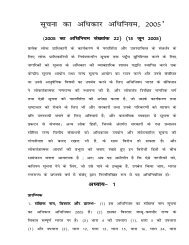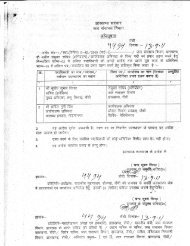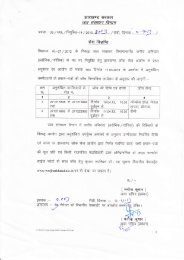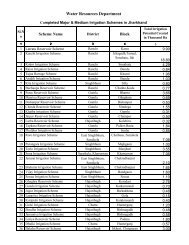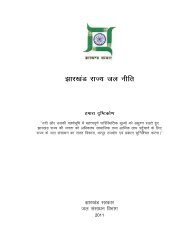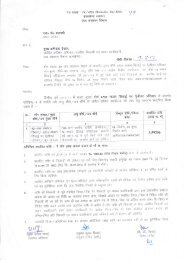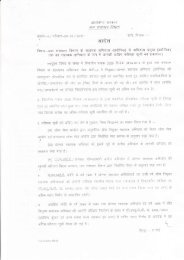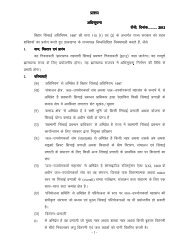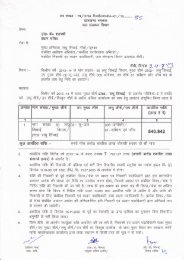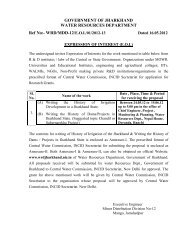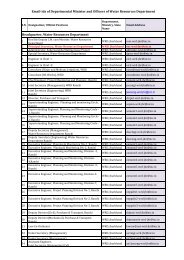Jharkhand State Water Policy
Jharkhand State Water Policy
Jharkhand State Water Policy
- No tags were found...
You also want an ePaper? Increase the reach of your titles
YUMPU automatically turns print PDFs into web optimized ePapers that Google loves.
esponsibility and powers of proposed river valley institutions. The <strong>State</strong> will also review theexisting institutional arrangement in the water sector and appropriately restructure and adjustthem.Fourth, the <strong>State</strong> will place a high priority on promoting technology to improve efficiency andproductivity, expansion of the knowledge base of the sector and the development of humanresource capacity and capability.Fifth, the <strong>State</strong> will formulate appropriate legislation/administrative orders and enabling rules togive effect to the above mentioned strategies in short time. To begin with, the <strong>State</strong> willintroduce farmer’s management of irrigation system and create <strong>State</strong> water authority, andriver basin authorities by enacting through appropriate act/legislation/rules/administrativeorders.2.0 <strong>Jharkhand</strong> <strong>State</strong> <strong>Water</strong> <strong>Policy</strong> – Our Vision“ To ensure the sustainable development and optimal use and management of the <strong>State</strong>’swater resources to provide the greatest economic and social benefit for the people of thestate of <strong>Jharkhand</strong> in a manner that maintains important ecological values within riversand adjoining lands. ”3.0 Objectives of the <strong>Jharkhand</strong> <strong>State</strong> <strong>Water</strong> <strong>Policy</strong> (JSWP)3.1 Integrated, Multi-sectoral and River Basin ApproachTo adopt an integrated and multi-sectoral approach to the water resources planning,development and management on a sustainable basis, taking river basin/sub-basin as a unit andtreating surface and sub-surface water with unitary approach.The management of the water resources of the <strong>State</strong> shall be decentralized to the lowestpracticable level on the basis of hydrologic or watershed unit. The <strong>State</strong> shall be divided intofive major river basins and appropriate river basin agencies/authorities shall be establishedwithin each/or group of river basins.G:\WATER POLICY\<strong>State</strong> <strong>Water</strong> <strong>Policy</strong> (correction copy)-26.9.11.doc - 6 -
The river basin agencies shall have the responsibility and authority for the integrated planning,development and management of the water resources, and watersheds of their respective riverbasins; for flood management, drought management, and operation and maintenance of waterstorages and delivery infrastructures. These river basin agencies shall prepare integrated riverbasin plan with the effective inclusion and participation of representatives of all basin water userentities, categories of water users and other stake holders. Such basin plan shall include adevelopment plan, a long-term operation plan, a monitoring plan, a comprehensive watershedmanagement plan, an efficiency improvement and water conservation plan, a wasteminimization and water quality management plan.4.0 <strong>State</strong> <strong>Water</strong> PlanBased on the water resources development and management plans developed by the respectiveriver basin agencies, the <strong>State</strong> shall prepare a <strong>State</strong> <strong>Water</strong> Resources Plan to promote a balanceddevelopment by proper coordination among diverse water uses which shall include structuralmeasures, operational measures, watershed management measures, demand managementmeasures such as conservation scheduling and efficient technologies, water pollution controlmeasures and monitoring measures that will assure comprehensive sustainable management ofthe water resources and equality of water distribution for the benefit of the <strong>State</strong> as well as to itspeople. Preparation of <strong>State</strong> <strong>Water</strong> Resources Plan will require convergence of variousdepartments and agencies of the <strong>State</strong> like <strong>State</strong> Environment and Forest Department,Agriculture Department, Drinking <strong>Water</strong> and Sanitation Department, <strong>State</strong> <strong>Water</strong>shedDevelopment Agency, <strong>State</strong> Pollution Control Board, etc.5.0 Inter-<strong>State</strong> <strong>Water</strong> SharingMost of the inter-<strong>State</strong> water sharing agreements were made by erstwhile Bihar <strong>State</strong>. With thecreation of <strong>Jharkhand</strong> <strong>State</strong> in 2000, the whole developmental scenario, for the <strong>State</strong> of <strong>Jharkhand</strong>,has undergone perceptible change. It has therefore become necessary to undertake performanceevaluation of all Inter-<strong>State</strong> water sharing arrangements and initiate necessary action to protect theinterest of the <strong>State</strong>.G:\WATER POLICY\<strong>State</strong> <strong>Water</strong> <strong>Policy</strong> (correction copy)-26.9.11.doc - 7 -
6.0 <strong>Water</strong>shed Development and ManagementIntegrated watershed development and management programme shall be encouraged inDrought-prone areas. In such areas, viable watershed programme shall be identified and plannedfor development.7.0 <strong>Water</strong> Resources of the <strong>State</strong>The water resources of the <strong>State</strong> shall be defined as all water, surface or sub-surface arisingwithin the <strong>State</strong> or passing through the <strong>State</strong> in any and all drainages and aquifers within the<strong>State</strong>.The geographical area of the state is 79 lakh ha. and cultivable area is 38 lakh ha. Out of this,80% of the area is drought prone. About 7% area is flood prone. The highly variable rainfall in<strong>Jharkhand</strong> ranging from 1000 to 1400 mm mainly occurs within four-month period betweenJune to September with the number of rainy days varying between 60 and 80. The estimatedaverage annual availability of water resources consists of 27.726 km 3 of surface water and 5.251km 3 of subsurface. Of the 16 river basin systems, more than 50% of this average annualavailability is found in the five major river basins (Subarnarekha, Damodar Barakar, North Koel,Gumani & South Koel) of the <strong>State</strong>.7.1 Irrigation for cultivable land7.1.1 <strong>State</strong> has a noble aim of providing irrigation facility to each cultivable plot of the <strong>State</strong>. Astrategy will be worked out to achieve this aim in a phased manner in each river basin of the<strong>State</strong> within a period of ten years taking into account the agro-climatic zones of the <strong>State</strong>. .7.1.2 The basic element of this strategy will be, preparing a computerized database of all cultivableplots and the irrigation source/projects available in the <strong>State</strong>. This data base shall havemultilayer information containing land capability, existing land use, cropping pattern, rainfallpattern and also the topography covering spatial and altitudinal variation. This data base will beuse to formulate project plan for ensuring irrigation in each plot of cultivable land. The <strong>State</strong>will identify a suitable agency for this purpose to create such data base within a definite timeframe.G:\WATER POLICY\<strong>State</strong> <strong>Water</strong> <strong>Policy</strong> (correction copy)-26.9.11.doc - 8 -
7.2 Optimal Utilization of Existing Irrigation Potential7.2.1 It is essential to achieve optimal utilization of existing irrigation potential created so far, frommajor, medium and minor irrigation projects. As for as possible, the renovation and maintenanceof all such projects through WUAs/federation of WUAs will be priority of the <strong>State</strong>. Theseworks will also be a priority, while allocating funds for various projects.7.2.2 It will be endeavour of the <strong>State</strong> to prepare a complete database of such projects and to completethe exercise of renovation and maintenance of such projects in a planned manner within a periodof five years.7.3 <strong>Water</strong> Users’ Participation in Planning, Development and Management of <strong>Water</strong>Resources<strong>Water</strong> users, through their recognized organizations or service providers, shall have increasedresponsibility and be empowered to participate effectively in water resources planning anddevelopment, the operation and maintenance of water infrastructures and facilities and tomanage their entitlement to water.7.3.1 Farmers’ Management for Irrigation SystemFarmers’ participation, through their <strong>Water</strong> Users' Association, in irrigation management shallbe made mandatory and it is intended that water will be allocated, supplied and charged onvolumetric basis to <strong>Water</strong> Users’ Associations (WUAs) only. The irrigation system shall bemanaged through WUAs as per provisions made in the appropriate act / administrative orders.The womens’ participation in the irrigation management shall also be ensured. WUAs will holda bulk entitlement to water use on behalf of their members and manage and distribute their bulkentitlement. These WUAs shall maintain all irrigation infrastructures up to the distributary levelwithin their jurisdiction and will be federated at the project level. The federation will beresponsible for operation and maintenance of canals, appurtenant structures and other facilitiescreated in the project.Panchayati Raj Institutions shall be involved in the management and conservation oftraditional water sources to cover the work of minor irrigation.G:\WATER POLICY\<strong>State</strong> <strong>Water</strong> <strong>Policy</strong> (correction copy)-26.9.11.doc - 9 -
7.4 <strong>Water</strong> Use EntitlementsThe <strong>State</strong> recognizes that there is considerable economic and social value in water user entitiesand service providers having a stable bulk entitlement to water. The <strong>State</strong> shall establish a welldefined,transparent system for water entitlements that cannot be unilaterally changed by anystate agency or authority. Entitlements to use the water resources of the <strong>State</strong>, as defined inregulations issued by the <strong>State</strong>, shall use rights of the recipient of the entitlement within thelimitations specified in the entitlement, shall be treated as such in the management, use andtransfer of the entitlements as prescribed by the <strong>State</strong> act, and the rules regulations under such anact. Appropriation of these entitlements will be prohibited for any reason without just andequitable compensation and mitigation of the impacts of such appropriation.7.5 Transfers of <strong>Water</strong> EntitlementsTransfer of all or a portion of water entitlement between entitlement holders in any category ofwater use and priority shall be permitted on both annual and seasonal basis based upon faircompensation of the administrative control of the appropriate state water authority or itsassignee.8.0 <strong>Water</strong> for Domestic Use8.1 Drinking <strong>Water</strong> for AllAdequate domestic water facilities shall be provided to the entire population both in urban andin rural areas to meet their domestic needs. Multipurpose projects shall invariably include adomestic water component wherever there is no alternative and adequate source of drinkingwater. Ecology and drinking water needs of human beings and animals shall be the firstpriority on any available water resource.8.1.1 A perspective plan to meet domestic water requirement shall be prepared and steps be taken toprovide adequate resources for this purpose in a phased manner. Planning shall be made to drawdrinking water directly from the reservoirs by taking into account the commitments made toother water consuming sectors. As far as possible, dedicated pipeline should be laid down forgetting supply of drinking water preferably from the reservoirs for avoiding loss of waterthrough canal or river.G:\WATER POLICY\<strong>State</strong> <strong>Water</strong> <strong>Policy</strong> (correction copy)-26.9.11.doc - 10 -
8.1.2 Efforts shall be made to fix up the water rates for making water supply self-sustaining, at leastto meet the O&M costs considering the socio-economic conditions of the population to beserved.8.2 Special Plan for Augmenting Drinking <strong>Water</strong> Facilities8.2.1 The demand for safe and clean drinking water is increasing with the increasing population, bothin rural as well as in urban areas. The percentage decadal growth of population in rural andurban areas during the decade 1991-2001, is 17.9% and 31.2% respectively whereas thisdecadal growth of population of the <strong>State</strong> during the decade 1991-2001 and 2001-2011,have been 24.55 % and 22.34 % respectively.8.2.2 In order to meet the increasing demand of safe and clean drinking water for the people of<strong>Jharkhand</strong>, a serious effort with time bound action plan shall be worked out to augment the livecapacity of existing reservoirs dedicated for supplying drinking water through desiltation or byadopting other effective technical interventions including saving water by checking leakages indrinking water supply pipe line under short-term measures. Whereas for boosting this effort, aseries of dedicated long-term measures, such as undertaking techno-economic feasibility studyof lifting water from river Ganga (an international river) from June to December taking intoconsideration of international agreement signed on sharing of Ganga water between India andBangladesh for partly supplying water for storing into a series of existing, on-going andproposed dams/ reservoirs for meeting the drinking water demand for non-monsoon period, andalso for supplementing irrigational needs.8.2.3 In view of growing urban population demand for drinking water, the Government will takeinitiative for the construction of large reservoirs near thickly populated cities for the supplydrinking water.8.3 Community Management of Drinking <strong>Water</strong> Supply and SanitationThe community will be effectively involved in the planning and management of drinking watersupply and sanitation facilities in the urban as well rural areas. Community level organizationand appropriate local level bodies shall manage, operate and maintain these services on day-todaybasis.G:\WATER POLICY\<strong>State</strong> <strong>Water</strong> <strong>Policy</strong> (correction copy)-26.9.11.doc - 11 -
9.0 <strong>Water</strong> for Industrial Use9.1 Allocation of water shall also be made to the industries from the balance water available in theriver basin after meeting the requirement of the sectors put under priority of water uses asindicated at para 19.0.9.2 The treatment of effluents by the existing and new industries should be done as per the statutoryprovisions under <strong>Water</strong> (Prevention and Control of Pollution) Act 1974. It will be mandatory forall pollution creating industries to install effluent treatment plants. Encouragement will be givenfor recycling or reuse of treated waste water.10.1 Participation of the Private Sector10.1 In each river basin of the <strong>State</strong>, the full and effective participation of private industrialists,commercial enterprises and water service providers will be sought and encouraged in thepreparation of river basin plan and in the sustainable management of water resources of the riverbasins.10.2 The participation of the private sector, in partnership with the Government or other competentauthority in the financing and implementation of water resources projects wherever appropriate,will be encouraged in order to introduce new technologies and to obtain innovative financingmanagement expertise, to improve the quality and cost-effectiveness of water services andaccountability to water users.11.0 <strong>Water</strong> Quality11.1 The quality of the water resources of the <strong>State</strong> shall be protected and preserved to its usability ina sustainable manner for the people of the <strong>State</strong>. The <strong>State</strong> shall under the provisions of <strong>Water</strong>(Prevention and Control of Pollution) Act, through the authorized agency establish a program ofcontrol of discharge of any pollutant to the surface and sub-surface water of the <strong>State</strong>. Thisprogram shall include the registration of any such discharge, the licensing and monitoring ofsuch discharges, the establishment of standards and acceptable and appropriate limits for anydischarge of pollutants into any river/tributory/nala/stream, etc. The river basin agencies shallG:\WATER POLICY\<strong>State</strong> <strong>Water</strong> <strong>Policy</strong> (correction copy)-26.9.11.doc - 12 -
consider the maintenance of water quality in the preparation of river basin plan, operation planand watershed development plan.11.3 The pollution of water resources of the <strong>State</strong> will be prohibitted and those polluting, contributingto the pollution or abetting the pollution of the water resources of the <strong>State</strong> shall be penalized asprovided in the laws and regulations of the <strong>State</strong> through its relevant <strong>State</strong> agencies.12.0 Monitoring, Creation and Strengthening of Hydrological InformationSystem (HIS)12.1 The collection, compilation, storage, analysis and use of accurate, comprehensive, timely, andquality hydrologic data and also data about the economic, social and environmental dimensionsis necessary and pre-requisite for wise water management. Good quality data will serve as akey to all hydrologic analysis.Therefore a concerted effort will be made for the creation and strengthening of HydrologicalInformation System for the entire <strong>State</strong> of <strong>Jharkhand</strong>. All decisions and management actions willbe based on analysis of such quality data.12.2 A modern integrated monitoring network for acquisition and transmission of hydrometeorologicaldata and information management system shall be established to supportplanning, project formulation and implementation, operation and decision making by the riverbasin agencies, all water users and water service providers, and <strong>State</strong> departments and otheragencies at the river basin, sub-basin and <strong>State</strong> level.12.3 All <strong>State</strong> and Central agencies, departments and entities – public or private – those who collect,maintain, collate or archive hydro-meteorological data shall contribute data to this informationsystem after ensuring its validity and accuracy. Full access to the data in this information systemshall be ensured to all water users and stake holders – public or private (on payment basis) andconcerned <strong>State</strong> and Central agencies and departments.G:\WATER POLICY\<strong>State</strong> <strong>Water</strong> <strong>Policy</strong> (correction copy)-26.9.11.doc - 13 -
13.0 Benchmarking of <strong>Water</strong> Resources ProjectsThe performance of water resources projects and service delivery through these projects forvarious water user sectors shall be improved by increasing the efficiency, transparency andaccountability of the personnel responsible for providing services and seeking participation ofusers.Benchmarking is a very powerful management tool for analyzing and improving performance ofwater resources projects. Therefore, the Government will undertake the benchmarking exercisein all the projects in the <strong>State</strong> in a phased manner in such a way that all projects are coveredunder benchmarking exercise in a period of about five years.14.0 <strong>Water</strong> AuditFor optimal utilization of created irrigation potential available in the <strong>State</strong>, water audit isnecessary. <strong>Water</strong> audit will be compulsory for all water resources projects. The serviceproviders shall be accountable for providing measuring devices for volumetric supply and alsofor giving the account of water use in various sectors.15.0 Conservation of <strong>Water</strong>15.1 The efficiency of utilization of water in all its diverse uses shall be improved and an awarenessof water as a scarce resource shall be fostered. Conservation consciousness shall bepromoted through education, regulation, incentives and disincentives.15.2 Rain water harvesting shall be given due consideration in planning water resources. Viableprojects especially in scarce groundwater areas shall be investigated and implemented toincrease the surface water availability. Such projects would also help in recharging thegroundwater.15.3 Recycling and reuse of water have to be attempted for augmentation of water resources. Thiswill include reclaiming usable water from sewage after necessary effluent treatment. This shallbe made mandatory for industrial use.15.4 Measures to control the evaporation from the water bodies shall be taken up and efforts will bemade to make the process more cost-effective.G:\WATER POLICY\<strong>State</strong> <strong>Water</strong> <strong>Policy</strong> (correction copy)-26.9.11.doc - 14 -
15.5 Program of water literacy should be launched right from primary school level so as to createawareness about the importance of economizing the use of water among the diverse users.15.6 The water conservation works shall be taken on top priority where groundwater table hasconsiderably gone down and the Central Government has declared the area as dark zone.15.7 The water conservation works (village tanks, percolation tanks and K.T. weirs) in the commandarea of the completed major and medium projects shall be taken up, as per the requirement,where water supply is inadequate and irregular for irrigation purpose.16.0 Drought Management16.1 A systematic approach for drought prediction and assessment will be made for effectivelytackling the recurrent drought situation prevailing in certain areas of the <strong>State</strong>. Such droughtproneareas shall be made less vulnerable to drought associated problems through soil-moistureconservation measures (farm tanks, nala training, percolation tanks, K.T. weirs), waterharvesting practices, minimization of evaporation losses, development of the groundwaterpotential including recharging and the transfer of surplus surface water from one river basin ofthe <strong>State</strong> into deficit river basin where ever feasible and appropriate.16.2 Pastures, forestry or other modes of development, which are relatively less water-demanding,shall be encouraged. In planning water resources development projects, the needs of droughtproneareas shall be given priority. Economic viability shall be given weightage while decidingthe technical feasibility of a water resources project. Modern irrigation system, such as drip andsprinkler irrigation, be encouraged. In planning and regulation of irrigation projects, eightmonthly cropping pattern shall be adopted.16.3 The distress in water availability during deficit period shall be shared equitably amongstdifferent sectors of water users either located in the upstream or downstream. The norms ofsupply of water for domestic use shall be different for different river sub-basins of the <strong>State</strong>depending upon the status of water availability in these river basins.16.4 Relief works undertaken for providing employment to drought-hit population shall preferably befor drought proofing. <strong>Water</strong> resources development works under draught proofing measuresshall be given top priority.G:\WATER POLICY\<strong>State</strong> <strong>Water</strong> <strong>Policy</strong> (correction copy)-26.9.11.doc - 15 -
17.0 <strong>Water</strong> Resources Planning and Principles17.1 The water resources of the <strong>State</strong> shall be used, conserved and managed to provide the maximumeconomic and social benefit for the people of the <strong>State</strong> and in a manner that minimizes regionalimbalance and maintain important ecological values within rivers and adjoining lands. Allagencies of the <strong>State</strong> shall ensure the the optimum integrated benefit will be derived from the<strong>Water</strong> resources of the <strong>State</strong>.17.2 <strong>Water</strong> resource development projects and programs shall be planned and formulated taking intoaccount the full range of costs and benefits including economic, environmental, social and offsiteor external costs and benefits. <strong>Water</strong> resource development projects and programs thatmaximize benefits and minimize costs and are economically viable and technically feasible willbe undertaken.17.3 The planning of projects in hilly areas shall take into account the need to provide assureddrinking water, possibilities of hydropower development and the proper approach to irrigationin such areas in the context of physical features and constraints of the basin such as steepslopes, rapid run-off and the incidence of soil erosion. The economical norms of projects in sucharea shall be different than the norms in the normal area.17.4 <strong>Water</strong> resources development projects shall be planned according to present and futureavailability of water and be developed with basin/sub-basin as a unit.17.5 The water resources available to the <strong>State</strong> shall be brought within the category of utilizableresources to the maximum possible extent. The resources shall be conserved and the availabilitybe augmented by adopting measures for maximizing retention, eliminating pollution andminimizing losses. For this, measures like use of evaporetardants and other suitable measures tocontrol evaporation from storages and distribution, selective lining in the conveyance system,modernization and rehabilitation of existing systems including tanks, recycling and reuse oftreated effluents and adoption of traditional techniques like mulching or pipe irrigation and newtechniques like drip and sprinkler be promoted, wherever feasible.17.6 Non-conventional methods for utilization of water such as through intra-<strong>State</strong> river basintransfer of surplus water from a river basin into deficit basin, artificial recharge of groundwater,rainwater harvesting, etc. may be practiced to further increase the utilizable water resources.17.7 Short-duration and low-water consuming crops should be encouraged.G:\WATER POLICY\<strong>State</strong> <strong>Water</strong> <strong>Policy</strong> (correction copy)-26.9.11.doc - 16 -
17.8 Integrated and coordinated development of surface water, groundwater and their conjunctive useshall be envisaged right from the project planning stage and shall form an integral part of theproject.17.9 <strong>Water</strong> Resources Commission shall be constituted for the reassessment of water availabilityexisting in different river basins of the <strong>State</strong>.18.0 Flood <strong>Water</strong>- Planning and Management18.1 An emphasis will be given to capture the flood flow available in the river for a short duration bydiverting and storing it into natural depression pockets including abandoned mines, etc. to utilisefor different need-based priority sectors. For this, a comprehensive planning will be made byputting in place inflow-forecast system, including installation of telemetry at all the existingreservoirs as well as keeping provision for the on-going and proposed reservoirs of the <strong>State</strong> andaccessibility of meteorological long-term, medium-term & short-term monsoon forecast.18.2 Structural measures in the form of construction of embankments, anti-erosion works along theriver banks, etc. as well as non-structural measures in the form of afforestation in different riverbasins of the <strong>State</strong>, flood proofing, flood plain zoning, etc. shall be undertaken on need basis asand when required to safe guard the agricultural land from flood inundation and change in theriver morphology.19.0 Priority of <strong>Water</strong> Usage<strong>Water</strong> will be earmarked to the sectors as per the priority given below :(i) Domestic use for drinking, hygiene and sanitation needs of human beings includinglivestock;(ii) Ecology with respect to sustainability of water Resources;(iii) Irrigation for Agriculture including horticulture, herbal, aqua based agriculture,pisiculture, etc.;(iv) Hydel Power Development ;(v) Agro-based Industries;(vi) Industrial Development ; and(vii) All other useful proposes.G:\WATER POLICY\<strong>State</strong> <strong>Water</strong> <strong>Policy</strong> (correction copy)-26.9.11.doc - 17 -
The priority of the remaining water utility sectors except drinking can be changedconsidering the area specific needs. Irrigation development shall go hand-in-hand with thedevelopment of Hydel power generation.20.0 Physical and Financial Sustainability of <strong>Water</strong> ResourcesEnsuring sustainable and optimal benefit of the development of water resources shall be thejoint responsibility of the <strong>State</strong> and water users.21.0 Bulk <strong>Water</strong> Supply and <strong>Water</strong> Charges21.1 A transparent system of water tariff that recovers the cumulative cost of providing waterservices from all water user entities in all categories of water uses shall be established by the<strong>State</strong>. <strong>Water</strong> charges, determined on the basis of the approved water tariff system, will be leviedon a volumetric basis.21.2 <strong>Water</strong> charges shall be assessed and paid at each appropriate level of management and serviceprovision. Such charges will be sufficient to pay all administrative, operation and maintenancecost of the delivery and use of water and to recuperate all or a portion of the capital cost of theinfrastructure needed for the storage, delivery and use of that water.21.3 <strong>Water</strong> charges shall be assessed to WUAs and other water user entities on the basis of volume ofwater delivered at their respective off-takes. WUAs and other water user entities shall beresponsible for determining internal water charges and assessing each of its members to obtainthe funds required for paying water charges, carrying out necessary maintenance and for anyother purpose approved by the membership.21.4 In order to alleviate the impact of such charges on those unable to pay the complete charge, the<strong>State</strong> may allow cross-subsidies and allocate Governmental funds. In the event that suchmeasures are utilized, the aggregate amount of the cross-subsidies and Government funds shall,when combined with the regular water charges, be sufficient to recover all management,operation and maintenance cost of the delivery of water and the capital cost of the infrastructurenecessary for creating the storage and delivery of that water.G:\WATER POLICY\<strong>State</strong> <strong>Water</strong> <strong>Policy</strong> (correction copy)-26.9.11.doc - 18 -
22.0 Groundwater Management22.1 It has been observed that over exploitation of ground water in some of the blocks of the<strong>State</strong> like Chas, Ratu, Dhanbad, Ramgarh, Godda, Jamshedpur Sadar, Jharia and Kankeis done/being done.There shall be a periodical reassessment of the groundwater potential on a scientific basis takinginto consideration the quality of water available and economic viability.22.2 Exploitation of groundwater resources shall be so regulated to ensure social equity and also notto exceed the recharging possibilities. Groundwater recharge projects shall be the developmentalprojects. These projects shall be developed and implemented for augmenting the availablesupplies from ground water. Ground water legislation shall be enacted by taking intoaccount the model legislation communicated by the Govt. of India for the sustainablemanagement of ground water.23.0 Resettlement and RehabilitationOptimal use of water resources necessitates construction of storages and implementation ofconsequent resettlement and rehabilitation of policy. The <strong>State</strong> has already adopted arehabilitation policy to share the benefits of the project and ensure welfare of the affectedpeople. In case, where the resettlement and rehabilitation issues are involved, the <strong>State</strong> shallensure that the rehabilitation activities will be completed well before the completion of suchprojects. This principle will be followed scrupulously. Efforts shall be made to avoid the adverseimpacts of resettlement and rehabilitation on displaced population. The Project-affected peopleshall have the first right on the benefits from such projects.24.0 <strong>Water</strong> Zoning<strong>Water</strong> zoning; Drinking water zone, Ground water depletion zone, Flood affected zone,<strong>Water</strong> quality deterioration zone, based on the availability of water, shall be done for eachriver basin of the <strong>State</strong> considering the need of economic development in future andaccordingly the developmental plan for all the water usage sectors shall be prepared andG:\WATER POLICY\<strong>State</strong> <strong>Water</strong> <strong>Policy</strong> (correction copy)-26.9.11.doc - 19 -
implemented phase wise and in consultation, co-ordination and involvement with the concernedsectors.25.0 Maintenance and Modernization of Infrastructure FacilitiesThe responsible authorities including river basin agencies, WUAs, other water user entities andwater service providers, shall ensure and sustain the performance and function of all waterinfrastructures and facilities within their jurisdiction by implementing cost-effectively, timelyand in technically sound manner the maintenance and modernization of such infrastructure, andmanage and allocate funds to ensure that such maintenance programs are fully and effectivelyimplemented to achieve this objective. Wherever necessary old infrastructures/system shall berehabilitated and modernized so as to keep them in order.26.0 Cost-Effectiveness of <strong>State</strong> <strong>Water</strong> Services<strong>State</strong> departments, water service providers and the river basin agencies shall optimize the costof services including establishment, works, materials, energy and other cost and maintaintransparent account of the services and the sources of revenues and their allocation to variousfunctions and services.27.0 Financial Sustainability of <strong>Water</strong> ChargesThere is a need to ensure that the water charges for various uses shall be fixed in such a way thatthey cover at least the operation and maintenance of providing the service initially and a part ofthe capital cost with interest subsequently. These rates shall be linked directly to the quality ofservices to be provided. The subsidy on water rates to the disadvantaged and poorer sections ofthe society shall be well targeted and transparent.G:\WATER POLICY\<strong>State</strong> <strong>Water</strong> <strong>Policy</strong> (correction copy)-26.9.11.doc - 20 -
28.0 Investment Priorities and Plans28.1 Investment plans for the development of water resource projects and programs shall beformulated to ensure timely completion at the least cost and with maximum benefit. Projectpriorities and selection shall be consistent with current and projected limits of availablefinancing to ensure the timely completion of projects and programs and with the economicprinciples laid down in this water policy.28.2 In the context of multi-year programmes, individual sub-projects will be prioritized, selected andimplemented accordingly. While deciding the investment priorities preference shall be givento the projects which are at advanced stage.28.3 Time and cost overruns and deficient realization of benefits, characterising most of the waterrelated projects, shall be overcome by upgrading the quality of project preparation andmanagement. The underfunding of projects shall be obviated by an optimal allocation ofresources having regard to the early completion of ongoing projects as well as the need to reduceregional imbalances.29.0 Safety of <strong>Water</strong> Resources InfrastructuresThe safety of all structures including dams and canals that have been or will be constructed todevelop water resources, shall be ensured through state-wise program of periodic inspection asper the standards and procedures established by the <strong>State</strong>.30.0 Research, Development and Promotion of <strong>State</strong>-of-Art Technology in <strong>Water</strong>Sector30.1 Introduction of new technology for more efficient and productive water-use namely drip andsprinkler, management, the continuous development and dissemination of knowledge andinformation will be given importance for the optimal development and use of water resourcesfor the benefit of people of the <strong>State</strong>. The reuse of water for non-irrigation and non-drinkingpurposes by recycling and effluent treatment should be promoted. The <strong>State</strong> shall undertake topromote the development, adaptation and dissemination of affordable and appropriate water andagricultural technology, and expand the knowledge base through its various institutions.G:\WATER POLICY\<strong>State</strong> <strong>Water</strong> <strong>Policy</strong> (correction copy)-26.9.11.doc - 21 -
31.0 Human Resources Development31.1 Improved water services and management in future will require increased capacity andcapability of water users, officers of the <strong>State</strong> agencies. The <strong>State</strong> shall formulate comprehensiveand innovative programmes to impart training and knowledge to water-users and Governmentofficials.31.2 The <strong>State</strong> shall make all out efforts to encourage technical competency and integrity among theofficers of the <strong>State</strong> agency. This will be done by introducing an appropriate system of rewardsincluding out of turn promotion for the exemplary services such as, timely completion ofprojects with desired quality, implementing innovative ideas and concepts for optimal andefficient use of water in all its diverse perspectives to boost the economy of the people of the<strong>State</strong>.32.0 Periodical Review of <strong>Policy</strong>The <strong>State</strong> water policy, as per the actual requirement, will be reviewed as and when required,but normally after every five years or so.******G:\WATER POLICY\<strong>State</strong> <strong>Water</strong> <strong>Policy</strong> (correction copy)-26.9.11.doc - 22 -



